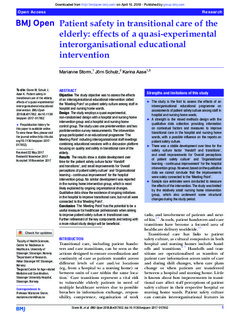| dc.contributor.author | Storm, Marianne | |
| dc.contributor.author | Schulz, Jörn | |
| dc.contributor.author | Aase, Karina | |
| dc.date.accessioned | 2018-04-11T07:40:24Z | |
| dc.date.available | 2018-04-11T07:40:24Z | |
| dc.date.created | 2017-12-12T15:38:04Z | |
| dc.date.issued | 2018-01 | |
| dc.identifier.citation | Storm, M., Schulz, J., Aase, K. (2018) Patient safety in transitional care of the elderly: effects of a quasi-experimental interorganisational educational intervention. BMJ Open. 2018;8:e017852 . | nb_NO |
| dc.identifier.issn | 2044-6055 | |
| dc.identifier.uri | http://hdl.handle.net/11250/2493550 | |
| dc.description.abstract | Objective The study objective was to assess the effects of an interorganisational educational intervention called the ‘Meeting Point’ on patient safety culture among staff in hospital and nursing home wards.
Design The study employs a quasi-experimental, non-randomised design with a hospital and nursing home intervention group and a hospital and nursing home control group. The study uses one preintervention and two postintervention survey measurements. The intervention group participated in an educational programme ‘The Meeting Point’ including interorganisational staff meetings combining educational sessions with a discussion platform focusing on quality and safety in transitional care of the elderly.
Results The results show a stable development over time for the patient safety culture factor ‘Handoff and transitions’, and small improvements for ‘Overall perceptions of patient safety culture’ and ‘Organisational learning - continuous improvement’ for the hospital intervention group. No similar development was reported in the nursing home intervention group, which is most likely explained by ongoing organisational changes. Qualitative data show the existence of ongoing initiatives in the hospital to improve transitional care, but not all were connected to the ‘Meeting Point’.
Conclusion The ‘Meeting Point’ has the potential to be a useful measure for healthcare professionals when aiming to improve patient safety culture in transitional care. Further refinement of the key components and testing with a more robust study design will be beneficial. | nb_NO |
| dc.language.iso | eng | nb_NO |
| dc.publisher | BMJ Open | nb_NO |
| dc.rights | Navngivelse 4.0 Internasjonal | * |
| dc.rights.uri | http://creativecommons.org/licenses/by/4.0/deed.no | * |
| dc.subject | pasientsikkerhet | nb_NO |
| dc.subject | eldre pasienter | nb_NO |
| dc.title | Patient safety in transitional care of the elderly: effects of a quasi-experimental interorganisational educational intervention | nb_NO |
| dc.type | Journal article | nb_NO |
| dc.type | Peer reviewed | nb_NO |
| dc.description.version | publishedVersion | nb_NO |
| dc.rights.holder | © Article authors | nb_NO |
| dc.subject.nsi | VDP::Medical disciplines: 700 | nb_NO |
| dc.source.pagenumber | 17 | nb_NO |
| dc.source.volume | 2018 | nb_NO |
| dc.source.journal | BMJ Open | nb_NO |
| dc.source.issue | 8 | nb_NO |
| dc.identifier.doi | 10.1136/bmjopen-2017-017852 | |
| dc.identifier.cristin | 1526400 | |
| dc.relation.project | Norges forskningsråd: 204637 | nb_NO |
| cristin.unitcode | 217,13,0,0 | |
| cristin.unitname | Det helsevitenskapelige fakultet | |
| cristin.ispublished | false | |
| cristin.fulltext | original | |
| cristin.qualitycode | 1 | |

